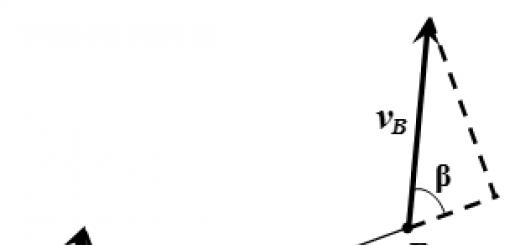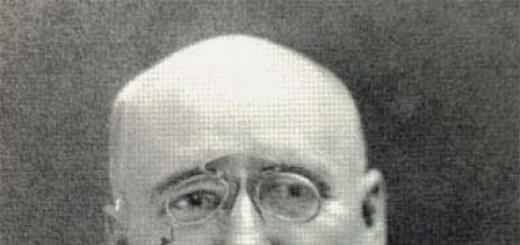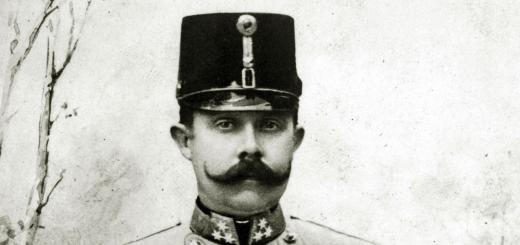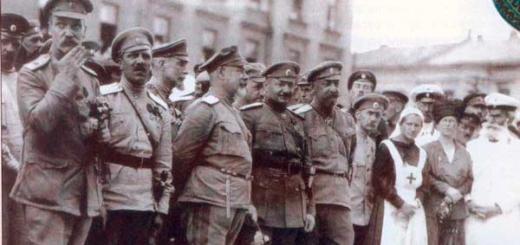Radio, television, the first artificial satellite, color photography and much more are inscribed in the history of Russian inventions. These discoveries laid the foundation for the phenomenal development of various fields in the field of science and technology. Of course, everyone knows some of these stories, because sometimes they become almost more famous than the inventions themselves, while others remain in the shadow of their high-profile neighbors.
1. Electric car
It is difficult to imagine the modern world without cars. Of course, more than one mind had a hand in the invention of this transport, and in improving the machine and bringing it to its present state, the number of participants increases significantly, geographically bringing together the whole world. But we will separately note Ippolit Vladimirovich Romanov, since he was responsible for the invention of the world's first electric car. In 1899, in St. Petersburg, an engineer introduced a four-wheeled carriage designed to carry two passengers. Among the features of this invention, it can be noted that the diameter of the front wheels was significantly greater than the diameter of the rear ones. The maximum speed was 39 km/h, but a very complex charging system made it possible to travel only 60 km at this speed. This electric car became the forefather of the trolleybus as we know it.
2. Monorail
And today monorails make a futuristic impression, so one can imagine how incredible by the standards of 1820 the “pole road” invented by Ivan Kirillovich Elmanov was. The horse-drawn trolley moved along a beam that was mounted on small supports. To Elmanov’s great regret, there was no philanthropist who was interested in the invention, which is why he had to abandon the idea. And only 70 years later the monorail was built in Gatchina, St. Petersburg province.
3. Electric motor
Boris Semenovich Jacobi, an architect by training, at the age of 33, while in Konigsberg, became interested in the physics of charged particles, and in 1834 he made a discovery - an electric motor operating on the principle of rotation of the working shaft. Jacobi instantly became famous in scientific circles, and among many invitations for further study and development, he chose St. Petersburg University. So, together with academician Emilius Christianovich Lentz, he continued work on the electric motor, creating two more options. The first was intended for a boat and rotated the paddle wheels. With the help of this engine, the ship easily stayed afloat, even moving against the current of the Neva River. And the second electric motor was the prototype of a modern tram and rolled a person in a cart along the rails. Among Jacobi's inventions, one can also note electroforming - a process that allows you to create perfect copies of the original object. This discovery was widely used to decorate interiors, houses and much more. The scientist’s achievements also include the creation of underground and underwater cables. Boris Jacobi became the author of about a dozen designs of telegraph apparatus, and in 1850 he invented the world's first direct-printing telegraph apparatus, which worked on the principle of synchronous movement. This device was recognized as one of the greatest achievements in electrical engineering of the mid-19th century.
4. Color photography
If previously everything that happened tried to get on paper, now all life is aimed at getting a photograph. Therefore, without this invention, which became part of the small but rich history of photography, we would not have seen such “reality”. Sergei Mikhailovich Prokudin-Gorsky developed a special camera and presented his brainchild to the world in 1902. This camera was capable of taking three photographs of the same image, each of which was passed through three completely different light filters: red, green and blue. And the patent received by the inventor in 1905 can, without exaggeration, be considered the beginning of the era of color photography in Russia. This invention is much better than the developments of foreign chemists, which is an important fact in view of the massive interest in photography around the world.
5. Bicycle
It is generally accepted that all information about the invention of the bicycle before 1817 is doubtful. The story of Efim Mikheevich Artamonov also comes into play at this time. The Ural serf inventor made the first bicycle ride around 1800 from the Ural workers' Tagil factory village to Moscow, the distance was about two thousand versts. For his invention, Efim was granted freedom from serfdom. But this story remains a legend, while the patent of the German professor Baron Karl von Dres from 1818 is a historical fact.
6. Telegraph
Humanity has always been looking for ways to transfer information from one source to another as quickly as possible. Fire, smoke from a fire, and various combinations of sound signals helped people transmit distress signals and other emergency messages. The development of this process is undoubtedly one of the most important tasks facing the world. The first electromagnetic telegraph was created by the Russian scientist Pavel Lvovich Schilling in 1832, presenting it in his apartment. He came up with a certain combination of symbols, each of which corresponded to a letter of the alphabet. This combination appeared on the device as black or white circles.
7. Incandescent lamp
If you say “incandescent lamp,” then the name Edison immediately comes to mind. Yes, this invention is no less famous than the name of its inventor. However, a relatively small number of people know that Edison did not invent the lamp, but only improved it. While Alexander Nikolaevich Lodygin, being a member of the Russian Technical Society, in 1870 proposed using tungsten filaments in lamps, twisting them into a spiral. Of course, the history of the invention of the lamp is not the result of the work of one scientist - rather, it is a series of successive discoveries that were in the air and were needed by the world, but it was Alexander Lodygin’s contribution that became especially great.
8. Radio
The question of who is the inventor of radio is controversial. Almost every country has its own scientist who is credited with creating this device. So, in Russia this scientist is Alexander Stepanovich Popov, in whose favor many weighty arguments are given. On May 7, 1895, the reception and transmission of radio signals at a distance was demonstrated for the first time. And the author of this demonstration was Popov. He was not only the first to put a receiver into practice, but also the first to send a radiogram. Both events occurred before the patent of Marconi, who is considered the inventor of radio.
9. Television
The discovery and widespread use of television broadcasting has radically changed the way information is disseminated in society. Boris Lvovich Rosing was also involved in this powerful achievement, who in July 1907 filed an application for the invention of a “Method for electrically transmitting images over distances.” Boris Lvovich managed to successfully transmit and receive an accurate image on the screen of what was still a simple device, which was a prototype of the kinescope of a modern television, which the scientist called an “electric telescope.” Among those who helped Rosing with his experience was Vladimir Zvorykin, a student at the St. Petersburg Institute of Technology - it was he, and not Rosing, who would be called the father of television several decades later, although the operation of all reproducing television devices was based on the principle discovered by Boris Lvovich in 1911.
10. Parachute
Gleb Evgenievich Kotelnikov was an actor in the troupe of the People's House on the St. Petersburg side. At the same time, impressed by the death of the pilot, Kotelnikov began developing a parachute. Before Kotelnikov, pilots escaped with the help of long folded “umbrellas” attached to the plane. Their design was very unreliable, and they greatly increased the weight of the aircraft. Therefore, they were used extremely rarely. Gleb Evgenievich proposed his completed project for a backpack parachute in 1911. But, despite successful tests, the inventor did not receive a patent in Russia. The second attempt was more successful, and in 1912 in France his discovery received legal force. But this fact did not help the parachute begin widespread production in Russia due to the fears of the head of the Russian air force, Grand Duke Alexander Mikhailovich, that at the slightest malfunction the aviators would abandon the airplane. And only in 1924 he finally received a domestic patent, and later transferred all rights to use his invention to the government.
11. Cinema camera
In 1893, working together with the physicist Lyubimov, Joseph Andreevich Timchenko created the so-called “snail” - a special mechanism with the help of which it was possible to intermittently change the sequence of frames in a strobe. This mechanism later formed the basis of the kinetoscope, which Timchenko developed together with engineer Freudenberg. The demonstration of the kinetoscope took place the following year at the congress of Russian doctors and naturalists. Two films were shown: “The Javelin Thrower” and “The Galloping Horseman”, which were filmed at the Odessa Hippodrome. There is even documentary evidence of this event. Thus, the minutes of the section meeting read: “Representatives of the meeting familiarized themselves with Mr. Timchenko’s invention with interest. And, in accordance with the proposals of the two professors, we decided to express gratitude to Mr. Timchenko.”
12. Automatic
Since 1913, inventor Vladimir Grigorievich Fedorov began work consisting of testing an automatic rifle (firing in bursts) chambered for a 6.5 mm caliber cartridge, which was the fruit of his development. Three years later, soldiers of the 189th Izmail Regiment are already being armed with such rifles. But serial production of machine guns was launched only after the end of the revolution. The designer's weapons were in service with the Russian army until 1928. But, according to some data, during the Winter War with Finland, troops still used some copies of the Fedorov assault rifle.
13. Laser
The history of the invention of the laser began with the name of Einstein, who created the theory of the interaction of radiation with matter. At the same time, Alexey Tolstoy, in his famous novel “The Hyperboloid of Engineer Garin,” wrote about the same thing. Until 1955, attempts to create a laser were not successful. And only thanks to two Russian physicist engineers - N.G. Basov and A.M. Prokhorov, who developed a quantum generator, the laser began its history in practice. In 1964, Basov and Prokhorov received the Nobel Prize in Physics.
14. Artificial heart
The name of Vladimir Petrovich Demikhov is associated with more than one operation that was performed for the first time. Surprisingly, Demikhov was not a doctor - he was a biologist. In 1937, as a third-year student at the Faculty of Biology at Moscow State University, he created a mechanical heart and gave it to a dog instead of a real one. The dog lived with the prosthesis for about three hours. After the war, Demikhov got a job at the Institute of Surgery of the USSR Academy of Medical Sciences and created a small experimental laboratory there, in which he began research on organ transplantation. Already in 1946, he was the first in the world to perform a heart transplant from one dog to another. That same year, he also performed the first heart and lung transplant on a dog at the same time. And most importantly, Demikhov’s dogs lived with transplanted hearts for several days. This was a real breakthrough in cardiovascular surgery.
15. Anesthesia
Since ancient times, humanity has dreamed of getting rid of pain. This was especially true for treatment, which was sometimes more painful than the illness itself. Herbs and strong drinks only dulled the symptoms, but did not allow them to perform serious actions accompanied by serious pain. This significantly hampered the development of medicine. Nikolai Ivanovich Pirogov is a great Russian surgeon, to whom the world owes many important discoveries, and made a huge contribution to anesthesiology. In 1847, he summarized his experiments in a monograph on anesthesia, which was published throughout the world. Three years later, for the first time in the history of medicine, he began to operate on the wounded with ether anesthesia in the field. In total, the great surgeon performed about 10,000 operations under ether anesthesia. Nikolai Ivanovich is also the author of topographic anatomy, which has no analogues in the world.
16. Mozhaisky’s plane
Many minds around the world worked to solve the most complex problems of aircraft development. Numerous drawings, theories and even test designs did not give a practical result - the plane did not lift a person into the air. The talented Russian inventor Alexander Fedorovich Mozhaisky was the first in the world to create a life-size airplane. Having studied the works of his predecessors, he developed and supplemented them, using his theoretical knowledge and practical experience. His results fully resolved the issues of his time and, despite a very unfavorable situation, namely the lack of actual capabilities in material and technical terms, Mozhaisky was able to find the strength to complete the construction of the world's first aircraft. It was a creative feat that forever glorified our Motherland. But the surviving documentary materials, unfortunately, do not allow us to describe in the necessary detail the aircraft of A.F. Mozhaisky and its tests.
17. Aerodynamics
Nikolai Egorovich Zhukovsky developed the theoretical foundations of aviation and methods for calculating aircraft - and this was at a time when the builders of the first aircraft argued that “an airplane is not a machine, it cannot be calculated,” and most of all relied on experience, practice and their intuition. In 1904, Zhukovsky discovered the law that determines the lifting force of an airplane wing, determined the main profiles of the wings and blades of an airplane propeller; developed the vortex theory of the propeller.
18. Atomic and hydrogen bomb
Academician Igor Vasilievich Kurchatov occupies a special place in the science of the twentieth century and in the history of our country. He, an outstanding physicist, played an exceptional role in the development of scientific and scientific-technical problems of mastering nuclear energy in the Soviet Union. The solution to this most difficult task, the creation in a short time of the nuclear shield of the Motherland in one of the most dramatic periods in the history of our country, the development of problems of the peaceful use of nuclear energy was the main work of his life. It was under his leadership that the most terrible weapon of the post-war era was created and successfully tested in 1949. No room for error, otherwise - execution... And already in 1961, a group of nuclear physicists from Kurchatov’s laboratory created the most powerful explosive device in the entire history of mankind - the AN 602 hydrogen bomb, which immediately acquired a completely appropriate historical name - “Tsar Bomba” " When testing this bomb, the seismic wave resulting from the explosion circled the globe three times.
19. Rocket and space technology and practical astronautics
The name of Sergei Pavlovich Korolev characterizes one of the most striking pages in the history of our state - the era of space exploration. The first artificial satellite of the Earth, the first manned flight into space, the first cosmonaut's spacewalk, the long-term operation of the orbital station and much more are directly related to the name of Academician Korolev - the first Chief Designer of rocket and space systems. From 1953 to 1961, Korolev’s every day was scheduled minute by minute: at the same time he worked on projects for a manned spacecraft, an artificial satellite and an intercontinental rocket. October 4, 1957 was a great day for world astronautics: after that, Sputnik flew through Soviet pop culture for another 30 years and was even registered in the Oxford Dictionary as “sputnik.” Well, about what happened on April 12, 1961, it’s enough to say “man in space,” because almost every one of our compatriots knows what we’re talking about.
20. Mi series helicopters
During the Great Patriotic War, Academician Mil worked in evacuation in the village of Bilimbay, mainly working on improving combat aircraft, improving their stability and controllability. His work was recognized with five government awards. In 1943, Mil defended his Ph.D. thesis “Criteria for aircraft controllability and maneuverability”; in 1945 - doctoral dissertation: “Dynamics of a rotor with articulated blades and its application to problems of stability and controllability of a gyroplane and helicopter.” In December 1947, M. L. Mil became the chief designer of an experimental helicopter design bureau. After a series of tests at the beginning of 1950, a decree was issued on the creation of an experimental series of 15 GM-1 helicopters under the designation Mi-1.
21. Airplanes of Andrei Tupolev
The design bureau of Andrei Tupolev developed more than 100 types of aircraft, 70 of which were mass-produced over the years. With the participation of his aircraft, 78 world records were set, 28 unique flights were completed, including the rescue of the crew of the Chelyuskin steamship with the participation of the ANT-4 aircraft. Non-stop flights of the crews of Valery Chkalov and Mikhail Gromov to the USA through the North Pole were carried out on ANT-25 model aircraft. ANT-25 aircraft were also used in the scientific expeditions “North Pole” by Ivan Papanin. A large number of bomber aircraft, torpedo bombers, reconnaissance aircraft designed by Tupolev (TV-1, TV-3, SB, TV-7, MTB-2, TU-2) and torpedo boats G-4, G-5 were used in combat operations in the Great Patriotic War. Patriotic War in 1941-1945. In peacetime, military and civilian aircraft developed under the leadership of Tupolev included the Tu-4 strategic bomber, the first Soviet jet bomber Tu-12, the Tu-95 turboprop strategic bomber, the Tu-16 long-range missile carrier-bomber, and the Tu-22 supersonic bomber; the first jet passenger aircraft Tu-104 (built on the basis of the Tu-16 bomber), the first turboprop intercontinental passenger airliner Tu-114, short- and medium-haul aircraft Tu-124, Tu-134, Tu-154. Together with Alexei Tupolev, the supersonic passenger aircraft Tu-144 was developed. Tupolev aircraft became the basis of the Aeroflot airline fleet, and were also operated in dozens of countries around the world.
22. Eye microsurgery
Millions of doctors, having received a diploma, are eager to help people and dream of future achievements. But most of them gradually lose their former passion: no aspirations, the same thing from year to year. Fedorov’s enthusiasm and interest in the profession only grew from year to year. Just six years after graduation, he defended his Ph.D. thesis, and in 1960, in Cheboksary, where he then worked, he performed a revolutionary operation to replace the lens of the eye with an artificial one. Similar operations were carried out abroad before, but in the USSR they were considered pure quackery, and Fedorov was fired from his job. After that, he became the head of the department of eye diseases at the Arkhangelsk Medical Institute. It was here that the “Fedorov empire” began in his biography: a team of like-minded people gathered around the irrepressible surgeon, ready for revolutionary changes in eye microsurgery. People from all over the country flocked to Arkhangelsk with the hope of regaining their lost sight - and they really did see. The innovative surgeon was also “officially” appreciated - he and his team moved to Moscow. And he began to do absolutely fantastic things: correct vision using keratotomy (special incisions on the cornea of the eye), transplant donor corneas, developed a new method of operating for glaucoma, and became a pioneer of laser eye microsurgery.
23. Tetris
Mid 80's. A time covered in legends. The idea of Tetris was born to Alexey Pajitnov in 1984 after meeting the puzzle of the American mathematician Solomon Golomb Pentomino Puzzle. The essence of this puzzle was quite simple and painfully familiar to any contemporary: from several figures it was necessary to assemble one large one. Alexey decided to make a computer version of pentominoes. Pajitnov not only took the idea, but also expanded it: in his game, you had to collect figures in a glass in real time, and the figures themselves consisted of five elements and could rotate around their own center of gravity during the fall. But the computers of the Computing Center were unable to do this - the electronic pentomino simply did not have enough resources. Then Alexey decides to reduce the number of blocks that made up the falling figures to four. This is how pentominoes became tetrominoes. Alexey calls the new game “Tetris”.
The 19th century laid the foundations for the development of 20th century science and created the preconditions for many of the future inventions and technological innovations that we enjoy today. Scientific discoveries of the 19th century were made in many fields and had a great influence on further development. Technological progress advanced uncontrollably. To whom are we grateful for the comfortable conditions in which modern humanity now lives?
Scientific discoveries of the 19th century: Physics and electrical engineering
James Clark Maxwell
A key feature in the development of science of this period of time is the widespread use of electricity in all branches of production. And people could no longer refuse to use electricity, having felt its significant benefits. Many scientific discoveries of the 19th century were made in this area of physics. At that time, scientists began to closely study electromagnetic waves and their effect on various materials. The introduction of electricity into medicine began.
In the 19th century, such famous scientists as the Frenchman Andre-Marie Ampère, two Englishmen Michael Faraday and James Clark Maxwell, and the Americans Joseph Henry and Thomas Edison worked in the field of electrical engineering.
In 1831, Michael Faraday noticed that if a copper wire moves in a magnetic field, crossing lines of force, an electric current arises in it. This is how the concept of electromagnetic induction appeared. This discovery paved the way for the invention of electric motors.
In 1865, James Clark Maxwell developed the electromagnetic theory of light. He suggested the existence of electromagnetic waves, through which electrical energy is transmitted in space. In 1883, Heinrich Hertz proved the existence of these waves. He also determined that their propagation speed is 300 thousand km/sec. Based on this discovery, Guglielmo Marconi and A. S. Popov created a wireless telegraph - radio. This invention became the basis for modern technologies for wireless information transmission, radio and television, including all types of mobile communications, the operation of which is based on the principle of data transmission via electromagnetic waves.
Chemistry

DI. Mendelev - a scientist who made many scientific discoveries in the 19th century
In the field of chemistry in the 19th century, the most significant discovery was D.I. Mendeleev's Periodic Law. Based on this discovery, a table of chemical elements was developed, which Mendeleev saw in a dream. In accordance with this table, he suggested that there were chemical elements then unknown. The predicted chemical elements scandium, gallium and germanium were subsequently discovered between 1875 and 1886.
Astronomy
XIX century was the century of formation and rapid development of another field of science - astrophysics. Astrophysics is a branch of astronomy that studies the properties of celestial bodies. This term appeared in the mid-60s of the 19th century. At its origins stood the German professor at the University of Leipzig, astronomer Johann Karl Friedrich Zöllner. The main research methods used in astrophysics are photometry, photography and spectral analysis. One of the inventors of spectral analysis is Kirchhoff. He conducted the first studies of the spectrum of the Sun. As a result of these studies, in 1859 he was able to obtain a picture of the solar spectrum and more accurately determine the chemical composition of the Sun.
Medicine and Biology
With the advent of the 19th century, science begins to develop at an unprecedented speed. There are so many scientific discoveries being made that it is difficult to track them in detail. Medicine and biology are not lagging behind in this regard. The most significant contributions in this area were made by the German microbiologist Robert Koch, the French physician Claude Bernard and the microbiological chemist Louis Pasteur.
Bernard laid the foundations of endocrinology - the science of the functions and structure of the endocrine glands. Louis Pasteur became one of the founders of immunology and microbiology. Pasteurization technology is named after this scientist- This is a method of heat treatment of mainly liquid products. This technology is used to destroy vegetative forms of microorganisms to increase the shelf life of food products such as beer and milk.
Robert Koch discovered the causative agent of tuberculosis, anthrax bacillus and Vibrio cholerae. He was awarded the Nobel Prize for his discovery of the tuberculosis bacillus.
Computers
Although it is believed that the first computer appeared in the 20th century, the first prototypes of modern machine tools with numerical control were built already in the 19th century. Joseph Marie Jacquard, a French inventor, came up with a way to program a weaving loom in 1804. The essence of the invention was that the thread could be controlled using punched cards with holes in certain places where the thread was supposed to be applied to the fabric.
Mechanical engineering and industry

Already at the beginning of the 19th century, a gradual revolution in mechanical engineering began. Oliver Evans was one of the first to demonstrate a steam-powered car in Philadelphia (USA) in 1804.
At the end of the 18th century, the first lathes appeared. They were developed by English mechanic Henry Maudsley.
With the help of such machines, it was possible to replace manual labor when it was necessary to process metal with great precision.
In the 19th century, the principle of operation of a heat engine was discovered and the internal combustion engine was invented, which served as an impetus for the development of faster means of transportation: steam locomotives, steamships and self-propelled vehicles, which we now call cars.
Railways also began to develop. In 1825, George Stephenson built the first railway in England. It provided rail links to the cities of Stockton and Darlington. In 1829, a branch line was laid that connected Liverpool and Manchester. If in 1840 the total length of railways was 7,700 km, then by the end of the 19th century it was already 1,080,000 km.
The 19th century is the century of the industrial revolution, the century of electricity, the century of railways. He had a significant impact on the culture and worldview of mankind and radically changed the human value system. The advent of the first electric motors, the invention of the telephone and telegraph, radio and heating devices, as well as incandescent lamps - all these scientific discoveries of the 19th century turned the lives of people of that time upside down.
Page 4 of 4
Invention of photography in the 19th century
One of the outstanding scientific and technical discoveries of the 19th century - photography, i.e. obtaining stable images on photosensitive materials under the influence of light rays - was the result of the work of many European scientists and inventors. Decisive successes at the last stage of the experiments were achieved by the French researchers J. N. Niepce and L. J. M. Daguerre. After the name of the latter, the method itself was called daguerreotype. But it was only in the 1840s, when, as a result of improvements in the photographic method, it was possible to obtain from negatives any number of positive prints on light-sensitive paper (and not just one, as with Daguerre’s method), the period of widespread use of photography began.
19th century road transport
In con. In the 19th century, a new type of transport arose - automobiles. In 1885-1886 German engineers K. Benz and G. Daimler designed the first models of cars, and from the 1890s. In a number of countries, industrial production of automobiles began, which led to increased construction of highways. The success of automobiles was facilitated by the introduction of pneumatic rubber tires in 1895 by Irish inventor J. Dunlop.
Steam shipping
The first steamship to receive practical use was the river ship "Clermont", built in 1807 by the American inventor Robert Fulton. The design of steam ships for a long time followed the established forms of sailing ships, and the steamships retained additional sailing equipment. A major role was played by the introduction of the propeller, the design of which was proposed by the Czech engineer Joseph Ressel and a little later by the Swedish engineer J. Erikson. Since the 1840s iron began to serve as a material for sheathing steamships, and then for the construction of ship hulls.
From the end 1860s Piston steam engines began to be used on sea vessels, and from 1894-1895. The first experiments were undertaken to replace piston engines with steam turbines, which significantly increased the power and speed of sea and ocean steam ships. The construction of canals was of great importance for the development of world trade. In 1869, the Suez Canal opened, which immediately acquired enormous international significance, shortening the route from England or the Netherlands to India by almost 13 thousand km.
First telegraph
In the 1st quarter of the 19th century, optical telegraphy became widespread throughout the European continent. In 1832, the Russian designer and engineer P. JI. Schilling demonstrated the electromagnetic telegraph he created, transmitting signs through the conditional position of the arrows in the station apparatus. S. F. B. Morse in the USA, K. A. Steingeil in Germany, and B. S. Jacobi in Russia worked on improving the electromagnetic telegraph. The Morse apparatus became the most widely used. The achievement of the following decades was the invention in 1850 of B. S. Jacobi of the direct-printing telegraph apparatus. However, the direct-printing apparatus designed in 1855 by the American designer D. E. Hughes became widespread. In 1876, the French mechanic E. Baudot patented the first practical five-fold telegraph apparatus, allowing five messages to be sent simultaneously. Since the 1840s. The laying of telegraph submarine cables begins between the most developed countries, as well as between metropolises and colonies.
Another branch of electrical engineering has become no less widespread - the design and practical use of telephone equipment. In the 1860-1870s. Experiments began on creating a telephone. In 1876, the American inventor A. Bell received a patent for the first practically usable telephone. Two years later, T. Edison and D. Hughes independently proposed the design of a microphone that was missing from Bell’s apparatus. The first telephone exchange was built in 1877 in the USA, in 1879 in Paris, in 1881 in Berlin, St. Petersburg, Moscow, Odessa, Riga and Warsaw. In 1889, American inventor A. B. Strowger received a patent for an automatic telephone exchange.
In 1895, Russian scientist and inventor A. S. Popov demonstrated the first radio receiver that made it possible to receive and transmit signals over a distance without wires. At first, the new branch of communication technology was called “wireless signaling” or “wireless telegraphy” in all languages. The term “radio” appeared after the First International Conference on Wireless Telegraphy in 1903, where it was recommended for use
American film inventor Thomas Edison, who was able to make this form of entertainment technically feasible
The competition, sponsored by Scientific American in 1913, required participants to write essays on the 10 greatest inventions of “our time” (from 1888 to 1913), and the inventions had to be patentable and dated to the time of their “industrial introduction.”
Essentially, this assignment was based on historical perception. Innovation seems more remarkable to us when we see the changes it brings about. In 2016, we may not think much of Nikola Tesla or Thomas Edison because we are used to using electricity in all its forms, but at the same time we are impressed by the social changes that it has brought about. popularization of the Internet. 100 years ago people probably wouldn’t have understood what we were talking about.
Below are excerpts from the first and second prize essays, along with a statistical tally of all entries submitted. First place was awarded to William I. Wyman, who worked at the US Patent Office in Washington, thanks to which he was well aware of scientific and technological progress.
Essay by William Wyman
1. The 1889 electric furnace was “the only means capable of producing carborundum” (the hardest man-made material at that time). She also transformed aluminum from "merely valuable to a very useful metal" (reducing its cost by 98%) and "radically changed the metallurgical industry."
2. The steam turbine, invented by Charles Parsons, began mass production within the next 10 years. The turbine significantly improved the power supply system on ships, and was later used to support the operation of generators that produced electricity.

The turbine, invented by Charles Parsons, powered the ships. When given in sufficient quantity, they drove generators and produced energy
3. Gasoline car. In the 19th century, many inventors worked on creating a “self-propelled” car. Wyman, in his essay, mentioned Gottlieb Daimler's 1889 engine: “A hundred years of persistent but unsuccessful efforts to create a practically self-propelled machine proves that any invention that first fits into the stated requirements becomes an immediate success. Such success came to the Daimler engine.”
4. Movies. Entertainment will always be of great importance to everyone, and "the moving picture has changed the way many people spend their time." The technical pioneer Wyman cited was Thomas Edison.
5. Airplane. For “the realization of a centuries-old dream,” Wyman praised the invention of the Wright brothers, but at the same time emphasized its military applications and doubted the general usefulness of flying technology: “Commercially, the airplane is the least profitable invention of all those under consideration.”
Orville Wright conducts a demonstration flight at Fort Mere in 1908 and fulfills the requirements of the US Army

Wilbur Wright

6. Wireless telegraphy. Various systems have been used to transmit information between people for centuries, perhaps even millennia. In the US, telegraph signals became much faster thanks to Samuel Morse and Alfred Vail. Wireless telegraphy, invented by Guglielmo Marconi, later evolved into radio and thus freed information from cables.
7. Cyanide process. Sounds toxic, doesn't it? This process appears on this list for only one reason: it was performed to extract gold from ore. “Gold is the lifeblood of commerce,” and in 1913 international trade relations and national currencies were based on it.
8. Nikola Tesla's asynchronous motor. “This landmark invention is largely responsible for the widespread use of electricity in modern industry,” writes Wyman. Before electricity was available in homes, Tesla's AC machine generated 90% of the electricity used in manufacturing.
9. Linotype. This machine allowed publishers—primarily newspaper publishers—to compose text and produce it much faster and cheaper. This technology was as advanced as the printing press was considered at one time in relation to the handwritten scrolls that preceded it. It is possible that soon we will stop using paper for writing and reading, and the history of printing will be forgotten.
10. Electric welding process from Elihu Thomson. During the era of industrialization, electric welding allowed for faster production rates and better, more sophisticated machines for the manufacturing process.

Electric welding, created by Elihu Thomson, significantly reduced the cost of producing complex welding equipment
Essay by George Dow
The second best essay, by George M. Dowe, also from Washington, was more philosophical. He divided all inventions into three supporting sectors: manufacturing, transport and communications:
1. Electrical fixation of atmospheric nitrogen. As natural sources of fertilizer became depleted in the 19th century, artificial fertilizers enabled further agricultural expansion.
2. Preservation of sugar-containing plants. George W. McMullen of Chicago is credited with discovering a method for drying sugar cane and sugar beets for transportation. Sugar production became more efficient and soon sugar supplies increased significantly.
3. High-speed steel alloys. By adding tungsten to steel, "tools thus made could cut at tremendous speeds without sacrificing the hardening or cutting edge." The increased efficiency of cutting machines has been "nothing short of a revolution"
4. Lamp with tungsten filament. Another advance in chemistry: With tungsten replacing carbon in the filament, the light bulb is considered “improved.” As of 2016, they are being phased out worldwide in favor of compact fluorescent lamps, which are 4 times more efficient.
5. Airplane. Although it was not yet widely used for transportation in 1913, "Samuel Langley and the Wright brothers should receive major honors for their contributions to the development of powered flight."
6. Steam turbine. As in the previous list, the turbine deserves praise not only for its "use of steam as a prime mover" but also for its application in "electricity generation."
7. Internal combustion engine. In terms of transportation, Dow credits "Daimler, Ford and Duryea" the most. Gottlieb Daimler is a well-known pioneer of motor vehicles. Henry Ford began production of the Model T in 1908, which remained very popular until 1913. Charles Duryea created one of the earliest commercially successful gasoline vehicles after 1896.
8. A pneumatic tire that was originally invented by Robert William Thomson, a railway engineer. “What the track did for the locomotive, the pneumatic tire did for vehicles not tied to railroad tracks.” However, the essay acknowledges John Dunlop and William C. Bartlett, each of whom made major contributions to the development of automobile and bicycle tires.
9. Wireless communication. Dow praised Marconi for making wireless communications "commercially feasible." The author of the essay also left a comment that can be attributed to the development of the World Wide Web, stating that wireless communications were “developed primarily to meet the needs of commerce, but along the way it contributed to social interaction.”
10. Typesetting machines. The giant rotary press could produce enormous volumes of printed material. The weak link in the production chain was the assembly of printing plates. Linotype and monotype helped get rid of this shortcoming.
All submitted essays were collected and analyzed to create a list of inventions that were perceived as the most significant. Wireless telegraphy was in almost every text. "Airplane" came in second, although it was considered important only because of the potential of the aircraft. Here are the rest of the results:

The nineteenth century laid the foundations for the development of science and technology in the next century, and created the preconditions for many inventions and innovations that are still used today. What key inventions of the 19th century contributed to this?
Physics
A distinctive feature of this era was the spread of electricity and its use in almost all industries. Many discoveries were made due to this innovation. The most popular topic for physical research has become electromagnetic waves, as well as their ways of influencing various materials.
Electricity
1831 - Englishman Michael Faraday noticed that a wire moving in a magnetic field and crossing lines of force becomes a carrier of electric current. This phenomenon was called electromagnetic induction and was subsequently used to create electric motors.
Light vibrations
1865 - James Clark Maxwell suggested that there are waves by which electrical energy is transmitted in space. A little later, in 1883, Heinrich Hertz proved the veracity of this assumption - he discovered these waves and established the speed of their propagation - 300 thousand km/s. This is how the electromagnetic theory of light arose.
Radio waves
And, of course, it is impossible to imagine the inventions of the 19th century without the radio created by A.S. Popov. This device became the prototype of all modern types of communication.
Chemistry
The inventions of the 19th century in the field of chemistry are not so extensive. But it was in this century that D.I. Mendeleev discovered the Periodic Law, which served as the basis for the creation of the periodic table of elements - the cornerstone of modern chemistry.

Munit
This century is characterized by a very high rate of development of science, including medicine and biology. The greatest contributions in this area were made by three outstanding scientists: the German microbiologist Robert Koch and two Frenchmen - the chemist Louis Pasteur and the physician Claude Bernard. Robert Koch discovered the tuberculosis bacillus as the causative agent of the disease, Vibrio cholerae and the anthrax bacillus. For his first discovery he was awarded the Nobel Prize. Louis Pasteur is the founder of such sciences as microbiology and immunology. It is noteworthy that his name was given to a method of heat treatment of products - pasteurization. Claude Bernard founded endocrinology - the science of the structure and functions of the endocrine glands.
Technical inventions of the 19th century
Prototypes of computers
Naturally, in the nineteenth century there were no full-fledged computers - they appeared only in the next century. But even then the foundations for programming and mechanization of processes were laid, which were embodied in program-controlled weaving machines. 19th century inventions in the field of "programming" also boasted a machine that was controlled using a punched card.

Mechanical engineering and industry
In 1804, in Philadelphia, Oliver Evans first demonstrated to the public a car that was equipped with a steam engine. At the end of the previous century, automatic lathes began to appear, which subsequently replaced manual work in cases where the part had to be manufactured with great precision.
Conclusion
The inventions of the 19th and 20th centuries radically changed the lives of people of that time - after all, with the advent of such things as electricity, cars and wireless communications, culture and worldview changed forever.










